
Posted on June 10, 2024
Ultimately, the decade-long restoration project filled over 100 miles of ditches, restored more than 3,000 acres of wetlands and replanted more than 20,000 acres of tallgrass prairie.
POLK COUNTY, Minn. – When Tim Cowdery – a now-retired hydrologist for the U.S. Geological Survey – published a report in 2019 highlighting more than a decade of research at Glacial Ridge National Wildlife Refuge in northwest Minnesota, no one could have predicted the findings would get swept up in the tidal wave of a global pandemic that would hit just months later.
Thanks to COVID, though, that’s exactly what happened. A news release outlining the results from Cowdery’s research at Glacial Ridge – site of the largest prairie-wetland restoration project in U.S. history – wasn’t released until May 2021, nearly two years after the report came out.
The 80-plus-page report is titled, “The Hydrologic Benefits of Wetland and Prairie Restoration in Western Minnesota-Lessons Learned at the Glacial Ridge National Wildlife Refuge 2002-15.”
Last week marked a homecoming, of sorts, for Cowdery, as he returned to Glacial Ridge on Wednesday, May 29, for the first time in several years as part of a field tour hosted by The Nature Conservancy.
The tour marked TNC’s first chance to showcase Cowdery’s research, since the pandemic essentially derailed any previous opportunities.
Glacial Ridge story
The story of Glacial Ridge and how it became a national wildlife refuge is well known in conservation circles. In 2000, TNC purchased the 24,500-acre site in Polk County – known locally as the Tilden Farms land – for $9 million from a long-distance landowner who bought the property in 1970 basically as a tax write-off, said Jason Ekstein, who was involved in the early restoration efforts as a TNC employee beginning in 2002.
Ekstein, who now works for the Department of Natural Resources’ “Roving Crew” in northwest Minnesota, gave an overview of Glacial Ridge’s history to start last week’s field tour.
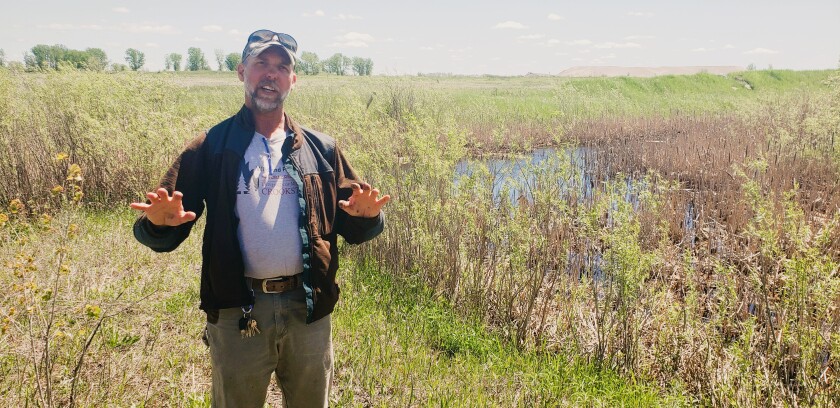
Jason Ekstein, who now works for the Minnesota Department of Natural Resources, was part of the early efforts to restore the 24,500-acre Polk County site that later became Glacial Ridge National Wildlife Refuge. Ekstein began working on the project in 2002 as a restoration ecologist for The Nature Conservancy, which bought the land in 2000. The project became the largest prairie-wetland restoration in U.S. history.
Glacial Ridge – named for the area’s sandy, beach ridge habitat left by glacial Lake Agassiz – originally was a patchwork of aspen, prairie and wetlands before it was developed for agriculture. When TNC bought the land, 19,000 acres had been converted to ag, Ekstein said. The owner had tried to sell the land in the late 1970s, he says, but no one could afford the asking price.
“So, they started buying Steigers,” Ekstein said, referring to the tractor maker with roots in nearby Red Lake Falls, Minnesota. “They bought seven Steigers, and they bought seven moldboard plows and started ripping up” the land.
“They ripped up a lot of ground,” he said. “They put a lot of effort into basically losing money.”
Focus on restoration
TNC’s goal in buying the land was “to restore natural water movement and restore the appropriate plant communities across the landscape,” Ekstein said. Funded largely by the U.S. Department of Agriculture’s Natural Resources Conservation Service through the Wetland Reserve Program, the project ultimately cost about $27 million, including purchase and restoration costs, according to a fact sheet TNC provided for tour participants.
Considering the property sold for $1 million in 1970 (about $2.4 million today, adjusted for inflation), protection would have been much cheaper in the long run, TNC said. Ultimately, the decade-long restoration project involved more than 30 partner organizations, filled over 100 miles of ditches, restored more than 3,000 acres of wetlands and replanted more than 20,000 acres of tallgrass prairie.
While NRCS funded the restoration, the Legislative Citizen Commission on Minnesota Resources (LCCMR) contributed funding for scientific research such as Cowdery’s hydrology study.
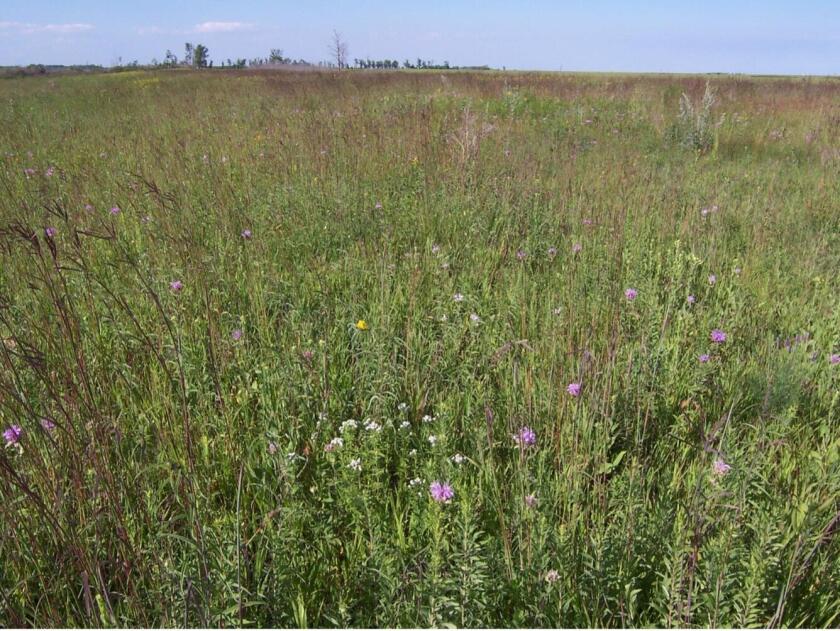
Prairie plants bloom on Lake Agassiz beach ridge lands at Glacial Ridge National Wildlife Refuge in this undated photo.
“USGS was asked early on – about the same time the property was bought – to do this pre-restoration study,” Cowdery said. “And that’s the part that never gets done in studies.
“This study has the great advantage of having a pretty good baseline before the restorations really took hold, to compare and really document quantitatively, the changes both in water flows and water quality on this land. TNC also was really interested in having expertise to deal with local politicians and landowners to reassure them that the sky was not going to fall as they did this (restoration).”
TNC ultimately transferred the restored land – a few thousand acres at a time – to the U.S. Fish and Wildlife Service to establish Glacial Ridge NWR. This year marks the 20th anniversary of the refuge.
Key findings
Without diving too deeply into the 80-page report – it’s not light reading – Cowdery’s hydrology research indicated that restoring the property’s wetlands and tallgrass prairie increased water quality, groundwater recharge and decreased flooding risks.
“Tim’s findings show that restoring grasslands and wetlands mitigates both flooding and drought,” said Christopher Anderson, marketing director for TNC in Minneapolis, who also attended the field tour. “And it also shows where and how additional restoration projects would have similar benefits.”
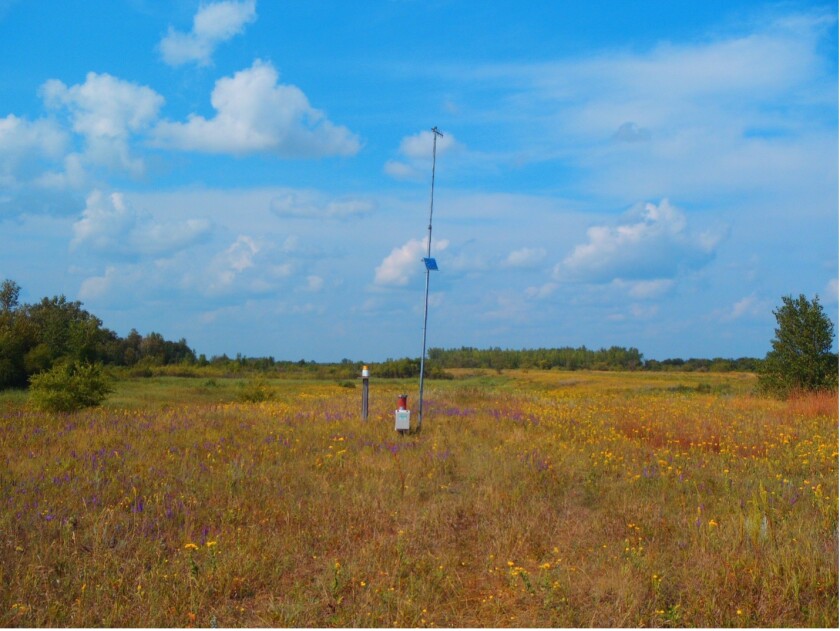
A water well at a restored prairie on Lake Agassiz beach ridge, Glacial Ridge National Wildlife Refuge, is seen in this undated photo.
Among the study findings highlighted on the TNC fact sheet:
- The rate of water runoff decreased by 33% as a result of the restoration. High runoff is undesirable because it can cause flooding and reduces the amount of water entering underground aquifers.
- The rate of groundwater recharge increased by 14%. Groundwater recharge is the process by which water soaks down from the land surface into an aquifer. Recharge helps maintain the amount of water stored in aquifers, which is used for drinking water and irrigation.
- Ditch flow decreased by 23%. That resulted in less water leaving the study area, helping to prevent flooding downstream.
- Concentrations of nitrate, a type of nutrient, decreased by 79% in groundwater and 53% in ditch water. Although nitrate is essential for plant growth, too much can harm or kill aquatic animals such as fish, affect the quality of water used for recreation and make the water unfit to drink.
- The city of Crookston’s major source of drinking water is the aquifers within and around Glacial Ridge National Wildlife Refuge.
As a scientist who specialized in the study of water, Cowdery says his work at Glacial Ridge was the highlight of his career with USGS. The pre-restoration part of his research began in 2002 and continued through 2005, Cowdery says, while post-restoration research was from 2012 through 2015.
At times, he made weekly trips from the Twin Cities to work at the restoration site.
“I spent half my career doing this, and it was by far the best (work) that I did with USGS,” he said.
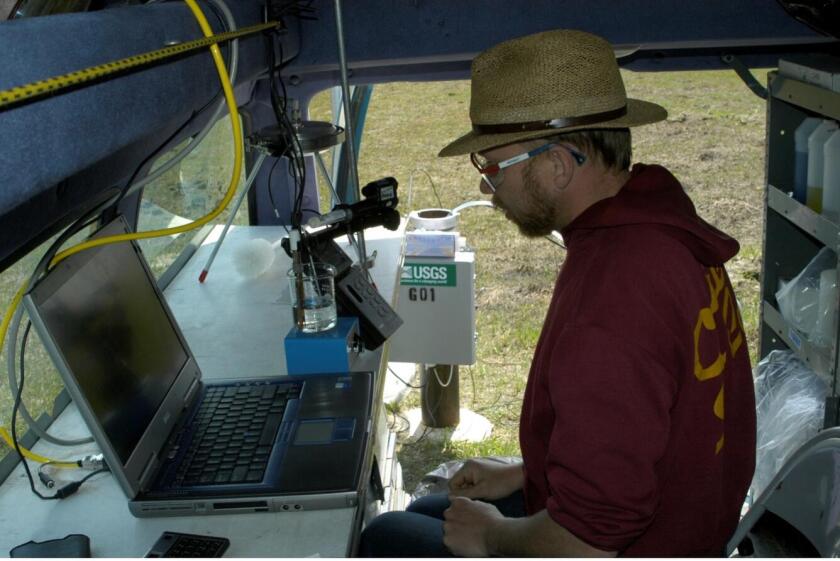
Tim Cowdery, a hydrologist for the U.S. Geological Survey who is now retired, assesses water alkalinity at Glacial Ridge National Wildlife Refuge while working in a mobile sampling van using an electronic field form in this undated photo.
Before Glacial Ridge, Cowdery says he’d never worked on a study this extensive.
“Nothing on this scale,” he said. “Nothing that wasn’t a model, like a groundwater flow model. I built a groundwater flow model for the Iron Range, for example, which is a bigger scale, but it’s not data.
“It’s not, ‘This is what happened. This is how the system works, we think.’ ”
Glacial Ridge today
The impact of the largest prairie restoration in U.S. history extends far beyond the obvious water quality and flood control benefits. Today, 20 years after its establishment as the 545th refuge in the National Wildlife Refuge System, Glacial Ridge NWR offers a variety of public-use opportunities, including birdwatching – prairie grouse-viewing blinds are especially popular every spring – and about 17,000 acres that are open to hunting for deer, waterfowl and a variety of upland game, including prairie chickens (by permit only), ruffed grouse and wild turkeys, said Gregg Knutsen, manager of Glacial Ridge and Rydell national wildlife refuges.
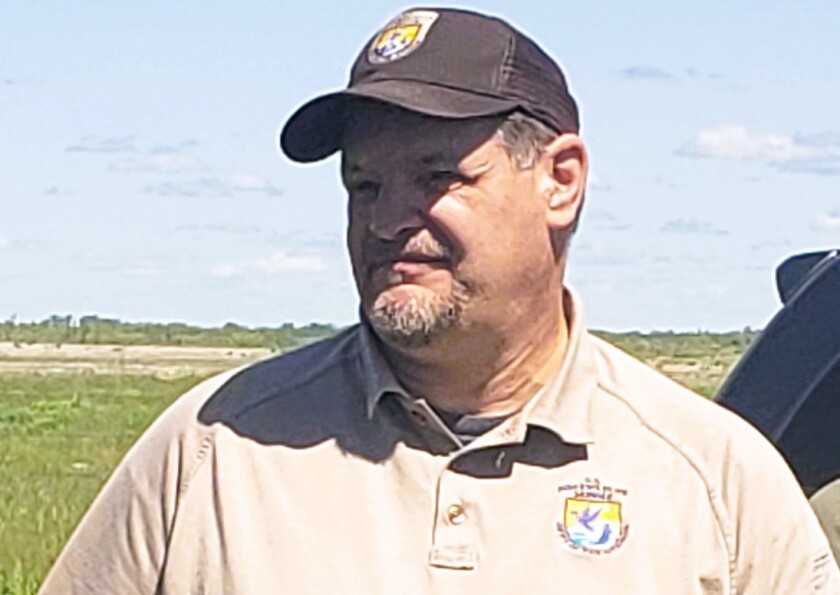
Gregg Knutson, manager of Glacial Ridge National Wildlife Refuge.
Others come simply to experience the prairie, he said. Managing the land through efforts such as prescribed fire and removing encroaching woody vegetation is an ongoing process, Knutsen said.
“Glacial Ridge is an open refuge,” he said. “You can wander out in the prairie and look around. Especially in the later part of the summer, we get a lot of prairie enthusiasts that come out. The prairies are full of color and a lot of different forbs (flowering plants) are out there.
“People come out and take a look and learn more about what’s on the landscape, whether it’s birds or prairie.”
- On the web:





